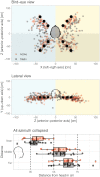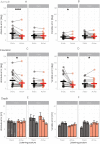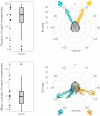Benefits of active listening during 3D sound localization
- PMID: 36071210
- PMCID: PMC9587935
- DOI: 10.1007/s00221-022-06456-x
Benefits of active listening during 3D sound localization
Abstract
In everyday life, sound localization entails more than just the extraction and processing of auditory cues. When determining sound position in three dimensions, the brain also considers the available visual information (e.g., visual cues to sound position) and resolves perceptual ambiguities through active listening behavior (e.g., spontaneous head movements while listening). Here, we examined to what extent spontaneous head movements improve sound localization in 3D-azimuth, elevation, and depth-by comparing static vs. active listening postures. To this aim, we developed a novel approach to sound localization based on sounds delivered in the environment, brought into alignment thanks to a VR system. Our system proved effective for the delivery of sounds at predetermined and repeatable positions in 3D space, without imposing a physically constrained posture, and with minimal training. In addition, it allowed measuring participant behavior (hand, head and eye position) in real time. We report that active listening improved 3D sound localization, primarily by ameliorating accuracy and variability of responses in azimuth and elevation. The more participants made spontaneous head movements, the better was their 3D sound localization performance. Thus, we provide proof of concept of a novel approach to the study of spatial hearing, with potentials for clinical and industrial applications.
Keywords: Active perception; Head movements; Motion tracking; Spatial hearing; Virtual reality.
© 2022. The Author(s).
Conflict of interest statement
The authors declare that they have no conflict of interest.
Figures







Similar articles
-
Spatial Hearing Difficulties in Reaching Space in Bilateral Cochlear Implant Children Improve With Head Movements.Ear Hear. 2022 Jan/Feb;43(1):192-205. doi: 10.1097/AUD.0000000000001090. Ear Hear. 2022. PMID: 34225320 Free PMC article.
-
Reaching to sounds in virtual reality: A multisensory-motor approach to promote adaptation to altered auditory cues.Neuropsychologia. 2020 Dec;149:107665. doi: 10.1016/j.neuropsychologia.2020.107665. Epub 2020 Oct 29. Neuropsychologia. 2020. PMID: 33130161
-
Reaching to Sounds Improves Spatial Hearing in Bilateral Cochlear Implant Users.Ear Hear. 2023 Jan-Feb 01;44(1):189-198. doi: 10.1097/AUD.0000000000001267. Epub 2022 Aug 19. Ear Hear. 2023. PMID: 35982520 Clinical Trial.
-
[Sound localization cues of binaural hearing].Laryngorhinootologie. 2003 Apr;82(4):240-8. doi: 10.1055/s-2003-38932. Laryngorhinootologie. 2003. PMID: 12717598 Review. German.
-
A review of the effects of unilateral hearing loss on spatial hearing.Hear Res. 2019 Feb;372:17-28. doi: 10.1016/j.heares.2018.08.003. Epub 2018 Aug 11. Hear Res. 2019. PMID: 30143248 Free PMC article. Review.
Cited by
-
Sound localization in noisy contexts: performance, metacognitive evaluations and head movements.Cogn Res Princ Implic. 2024 Jan 8;9(1):4. doi: 10.1186/s41235-023-00530-w. Cogn Res Princ Implic. 2024. PMID: 38191869 Free PMC article.
-
Spatial hearing training in virtual reality with simulated asymmetric hearing loss.Sci Rep. 2024 Jan 30;14(1):2469. doi: 10.1038/s41598-024-51892-0. Sci Rep. 2024. PMID: 38291126 Free PMC article.
-
Action toward sound sources enhances auditory spatial confidence: on the metacognitive consequences of reaching to sounds.Psychol Res. 2025 Jan 19;89(1):48. doi: 10.1007/s00426-025-02079-3. Psychol Res. 2025. PMID: 39827425 Free PMC article.
-
Spontaneous head-movements improve sound localization in aging adults with hearing loss.Front Hum Neurosci. 2022 Oct 13;16:1026056. doi: 10.3389/fnhum.2022.1026056. eCollection 2022. Front Hum Neurosci. 2022. PMID: 36310849 Free PMC article.
-
Adapting to altered auditory cues: Generalization from manual reaching to head pointing.PLoS One. 2022 Apr 14;17(4):e0263509. doi: 10.1371/journal.pone.0263509. eCollection 2022. PLoS One. 2022. PMID: 35421095 Free PMC article.
References
-
- Bahu H, Carpentier T, Noisternig M, Warusfel O. Comparison of different egocentric pointing methods for 3D sound localization experiments. Acta Acust Acust. 2016;102(1):107–118. doi: 10.3813/AAA.918928. - DOI
MeSH terms
Grants and funding
LinkOut - more resources
Full Text Sources

